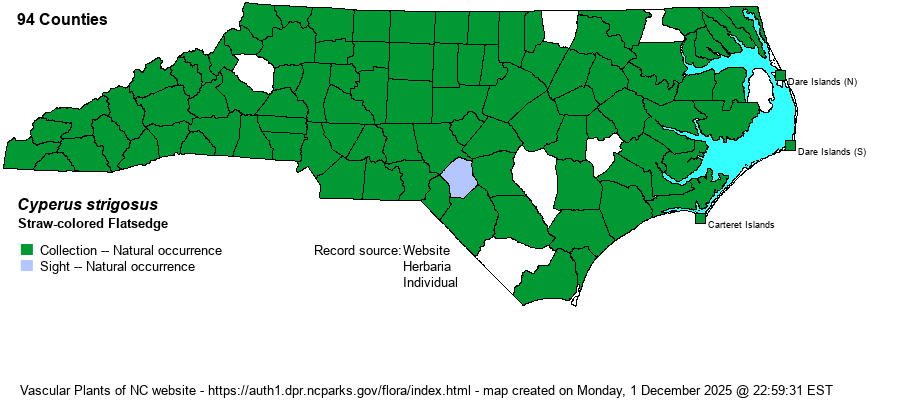| Author | L. | |
| Distribution | Throughout the state; doubtless in every county.
Que. to SD south to FL and TX; also western North America. | |
| Abundance | Common in the Mountains and Piedmont; frequent to common in the Coastal Plain. | |
| Habitat | Freshwater marshes, shores of impoundments, beaver ponds, wet meadows, wet to moist roadside ditches, wet flatwoods. |
| Phenology | Flowering and fruiting July-October. | |
| Identification | This flatsedge generally grows 1-2 feet tall, but may reach 3 feet. The inflorescence has many branches, and the spikes look straw-colored or pale golden brown. Always use mature plants to key out (!); immature ones can easily be mistaken for several other species. Achenes (seeds) are 3-sided (vs. 2-sided in some look-alikes) and the spikelets are flattened versus rather cylindrical in C. odoratus. | |
| Taxonomic Comments | Note that in the journal Castanea 87 (2022): 224, authors Lowe and Carter recognize var. strigosus and var. stenolepis as occurring in NC.
The genus Cyperus is mostly tropical and warm-temperate in distribution; thus, in NC it is much commoner in the Coastal Plain than in the Mountains and Piedmont. Most species have 1-few flowering stems (culms) from grasslike basal leaves, plus a few stem leaves. At the summit is an inflorescence of very open and branched, or tightly packed, spikes, varying among species from brown to golden brown to straw-color to reddish. The arrangement of the spikelets is important, whether like a hand (digitate) or in paired or alternate rows (pinnate); as is the shape of the achene (seed), whether bi-convex in cross-section or triangular. As a group, Cyperus tends to be weedy and readily enters disturbed ground; this is true for many natives as well as all the aliens. In recent years, following DNA research, the genus has incorporated several genera that in RAB (1968) or other manuals were separate: Hemicarpha, Lipocarpha, and Kyllinga. | |
| Other Common Name(s) | False Nutsedge | |
| State Rank | S5 | |
| Global Rank | G5 | |
| State Status | | |
| US Status | | |
| USACE-agcp | FACW link |
| USACE-emp | FACW link |

